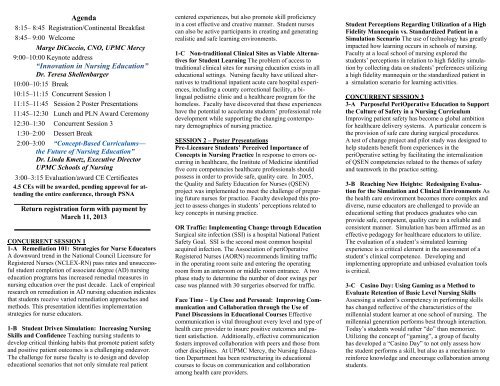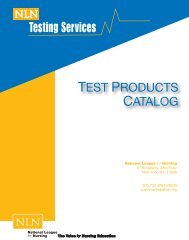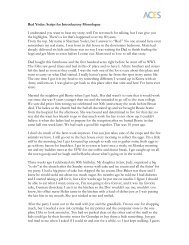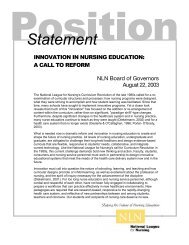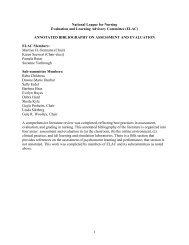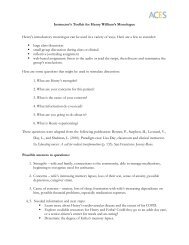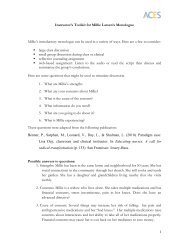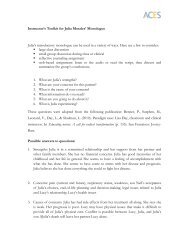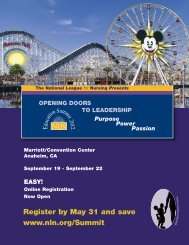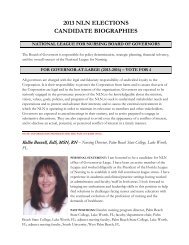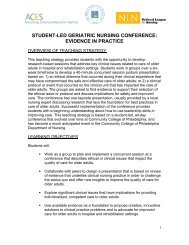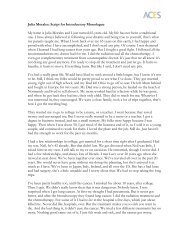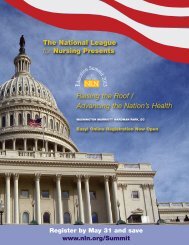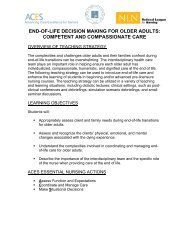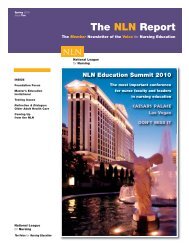5th Annual Best Practices in Nursing Education Conference
5th Annual Best Practices in Nursing Education Conference
5th Annual Best Practices in Nursing Education Conference
You also want an ePaper? Increase the reach of your titles
YUMPU automatically turns print PDFs into web optimized ePapers that Google loves.
Agenda<br />
8:15– 8:45 Registration/Cont<strong>in</strong>ental Breakfast<br />
8:45– 9:00 Welcome<br />
Marge DiCuccio, CNO, UPMC Mercy<br />
9:00–10:00 Keynote address<br />
“Innovation <strong>in</strong> Nurs<strong>in</strong>g <strong>Education</strong>”<br />
Dr. Teresa Shellenbarger<br />
10:00–10:15 Break<br />
10:15–11:15 Concurrent Session 1<br />
11:15–11:45 Session 2 Poster Presentations<br />
11:45–12:30 Lunch and PLN Award Ceremony<br />
12:30–1:30 Concurrent Session 3<br />
1:30–2:00 Dessert Break<br />
2:00–3:00 “Concept-Based Curriculums—<br />
the Future of Nurs<strong>in</strong>g <strong>Education</strong>”<br />
Dr. L<strong>in</strong>da Kmetz, Executive Director<br />
UPMC Schools of Nurs<strong>in</strong>g<br />
3:00–3:15 Evaluation/award CE Certificates<br />
4.5 CEs will be awarded, pend<strong>in</strong>g approval for attend<strong>in</strong>g<br />
the entire conference, through PSNA<br />
Return registration form with payment by<br />
March 11, 2013<br />
CONCURRENT SESSION 1<br />
1-A Remediation 101: Strategies for Nurse Educators<br />
A downward trend <strong>in</strong> the National Council Licensure for<br />
Registered Nurses (NCLEX-RN) pass rates and unsuccessful<br />
student completion of associate degree (AD) nurs<strong>in</strong>g<br />
education programs has <strong>in</strong>creased remedial measures <strong>in</strong><br />
nurs<strong>in</strong>g education over the past decade. Lack of empirical<br />
research on remediation <strong>in</strong> AD nurs<strong>in</strong>g education <strong>in</strong>dicates<br />
that students receive varied remediation approaches and<br />
methods. This presentation identifies implementation<br />
strategies for nurse educators.<br />
1-B Student Driven Simulation: Increas<strong>in</strong>g Nurs<strong>in</strong>g<br />
Skills and Confidence Teach<strong>in</strong>g nurs<strong>in</strong>g students to<br />
develop critical th<strong>in</strong>k<strong>in</strong>g habits that promote patient safety<br />
and positive patient outcomes is a challeng<strong>in</strong>g endeavor.<br />
The challenge for nurse faculty is to design and develop<br />
educational scenarios that not only simulate real patient<br />
centered experiences, but also promote skill proficiency<br />
<strong>in</strong> a cost effective and creative manner. Student nurses<br />
can also be active participants <strong>in</strong> creat<strong>in</strong>g and generat<strong>in</strong>g<br />
realistic and safe learn<strong>in</strong>g environments.<br />
1-C Non-traditional Cl<strong>in</strong>ical Sites as Viable Alternatives<br />
for Student Learn<strong>in</strong>g The problem of access to<br />
traditional cl<strong>in</strong>ical sites for nurs<strong>in</strong>g education exists <strong>in</strong> all<br />
educational sett<strong>in</strong>gs. Nurs<strong>in</strong>g faculty have utilized alternatives<br />
to traditional <strong>in</strong>patient acute care hospital experiences,<br />
<strong>in</strong>clud<strong>in</strong>g a county correctional facility, a bil<strong>in</strong>gual<br />
pediatric cl<strong>in</strong>ic and a healthcare program for the<br />
homeless. Faculty have discovered that these experiences<br />
have the potential to accelerate students’ professional role<br />
development while support<strong>in</strong>g the chang<strong>in</strong>g contemporary<br />
demographics of nurs<strong>in</strong>g practice.<br />
SESSION 2 – Poster Presentations<br />
Pre-Licensure Students’ Perceived Importance of<br />
Concepts <strong>in</strong> Nurs<strong>in</strong>g Practice In response to errors occurr<strong>in</strong>g<br />
<strong>in</strong> healthcare, the Institute of Medic<strong>in</strong>e identified<br />
five core competencies healthcare professionals should<br />
possess <strong>in</strong> order to provide safe, quality care. In 2005,<br />
the Quality and Safety <strong>Education</strong> for Nurses (QSEN)<br />
project was implemented to meet the challenge of prepar<strong>in</strong>g<br />
future nurses for practice. Faculty developed this project<br />
to assess changes <strong>in</strong> students’ perceptions related to<br />
key concepts <strong>in</strong> nurs<strong>in</strong>g practice.<br />
OR Traffic: Implement<strong>in</strong>g Change through <strong>Education</strong><br />
Surgical site <strong>in</strong>fection (SSI) is a hospital National Patient<br />
Safety Goal. SSI is the second most common hospital<br />
acquired <strong>in</strong>fection. The Association of periOperative<br />
Registered Nurses (AORN) recommends limit<strong>in</strong>g traffic<br />
<strong>in</strong> the operat<strong>in</strong>g room suite and enter<strong>in</strong>g the operat<strong>in</strong>g<br />
room from an anteroom or middle room entrance. A two<br />
phase study to determ<strong>in</strong>e the number of door sw<strong>in</strong>gs per<br />
case was planned with 30 surgeries observed for traffic.<br />
Face Time – Up Close and Personal: Improv<strong>in</strong>g Communication<br />
and Collaboration through the Use of<br />
Panel Discussions <strong>in</strong> <strong>Education</strong>al Courses Effective<br />
communication is vital throughout every level and type of<br />
health care provider to <strong>in</strong>sure positive outcomes and patient<br />
satisfaction. Additionally, effective communication<br />
fosters improved collaboration with peers and those from<br />
other discipl<strong>in</strong>es. At UPMC Mercy, the Nurs<strong>in</strong>g <strong>Education</strong><br />
Department has been restructur<strong>in</strong>g its educational<br />
courses to focus on communication and collaboration<br />
among health care providers.<br />
Student Perceptions Regard<strong>in</strong>g Utilization of a High<br />
Fidelity Mannequ<strong>in</strong> vs. Standardized Patient <strong>in</strong> a<br />
Simulation Scenario The use of technology has greatly<br />
impacted how learn<strong>in</strong>g occurs <strong>in</strong> schools of nurs<strong>in</strong>g.<br />
Faculty at a local school of nurs<strong>in</strong>g explored the<br />
students’ perceptions <strong>in</strong> relation to high fidelity simulation<br />
by collect<strong>in</strong>g data on students’ preferences utiliz<strong>in</strong>g<br />
a high fidelity mannequ<strong>in</strong> or the standardized patient <strong>in</strong><br />
a simulation scenario for learn<strong>in</strong>g activities.<br />
CONCURRENT SESSION 3<br />
3-A Purposeful PeriOperative <strong>Education</strong> to Support<br />
the Culture of Safety <strong>in</strong> a Nurs<strong>in</strong>g Curriculum<br />
Improv<strong>in</strong>g patient safety has become a global ambition<br />
for healthcare delivery systems. A particular concern is<br />
the provision of safe care dur<strong>in</strong>g surgical procedures.<br />
A test of change project and pilot study was designed to<br />
help students benefit from experiences <strong>in</strong> the<br />
periOperative sett<strong>in</strong>g by facilitat<strong>in</strong>g the <strong>in</strong>ternalization<br />
of QSEN competencies related to the themes of safety<br />
and teamwork <strong>in</strong> the practice sett<strong>in</strong>g.<br />
3-B Reach<strong>in</strong>g New Heights: Redesign<strong>in</strong>g Evaluation<br />
for the Simulation and Cl<strong>in</strong>ical Environments As<br />
the health care environment becomes more complex and<br />
diverse, nurse educators are challenged to provide an<br />
educational sett<strong>in</strong>g that produces graduates who can<br />
provide safe, competent, quality care <strong>in</strong> a reliable and<br />
consistent manner. Simulation has been affirmed as an<br />
effective pedagogy for healthcare educators to utilize.<br />
The evaluation of a student’s simulated learn<strong>in</strong>g<br />
experience is a critical element <strong>in</strong> the assessment of a<br />
student’s cl<strong>in</strong>ical competence. Develop<strong>in</strong>g and<br />
implement<strong>in</strong>g appropriate and unbiased evaluation tools<br />
is critical.<br />
3-C Cas<strong>in</strong>o Day: Us<strong>in</strong>g Gam<strong>in</strong>g as a Method to<br />
Evaluate Retention of Basic Level Nurs<strong>in</strong>g Skills<br />
Assess<strong>in</strong>g a student’s competency <strong>in</strong> perform<strong>in</strong>g skills<br />
has changed reflective of the characteristics of the<br />
millennial student learner at one school of nurs<strong>in</strong>g. The<br />
millennial generation performs best through <strong>in</strong>teraction.<br />
Today’s students would rather “do” than memorize.<br />
Utiliz<strong>in</strong>g the concept of “gam<strong>in</strong>g”, a group of faculty<br />
has developed a “Cas<strong>in</strong>o Day” to not only assess how<br />
the student performs a skill, but also as a mechanism to<br />
re<strong>in</strong>force knowledge and encourage collaboration among<br />
students.


